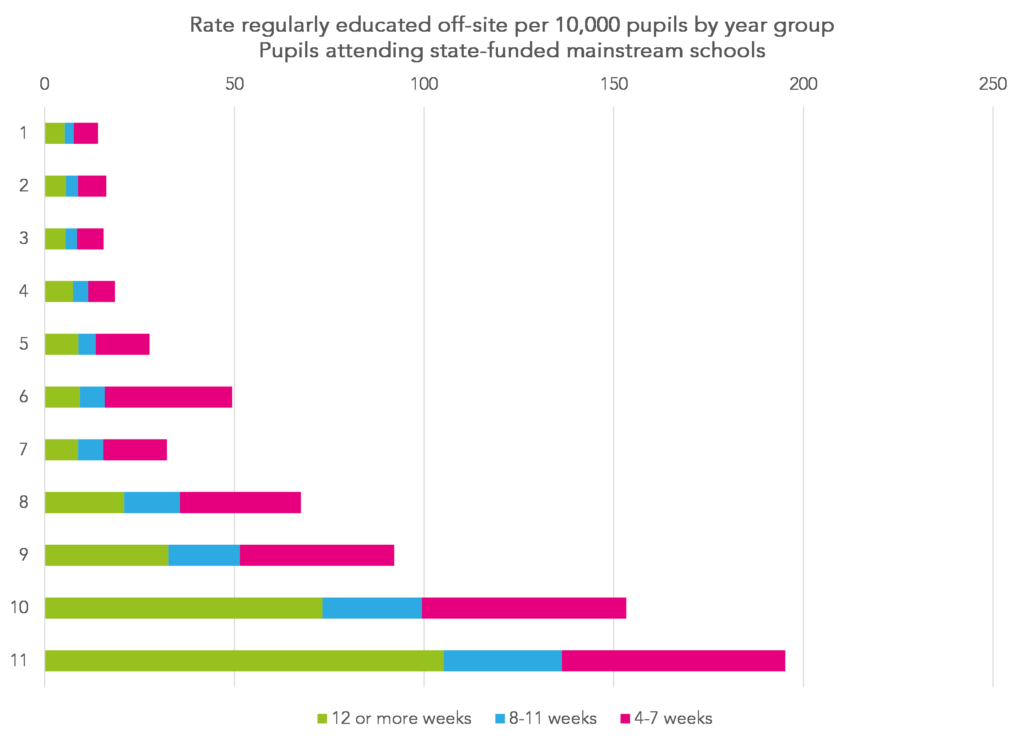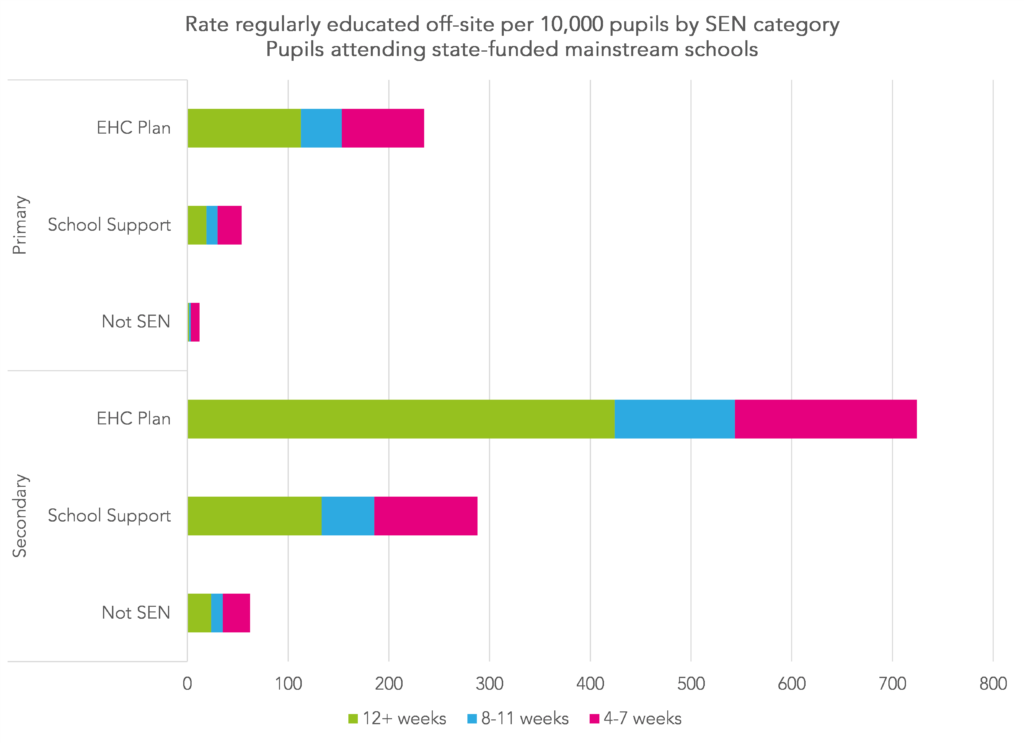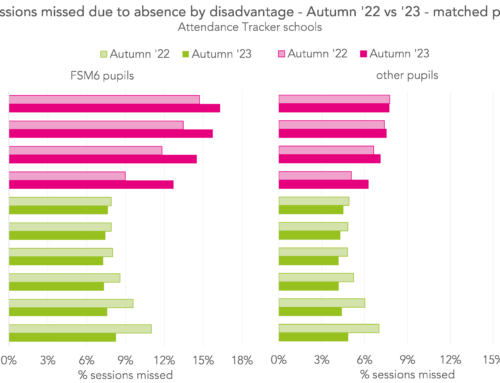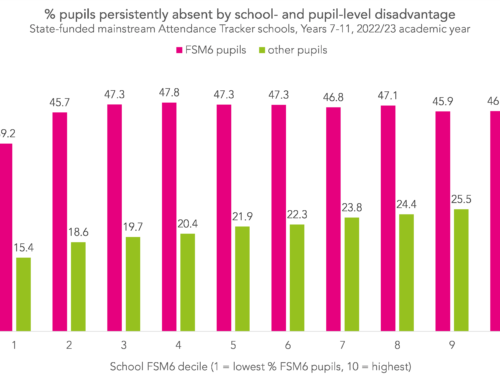In the Autumn we estimated that around 37,000 pupils enrolled at mainstream schools were educated off-site one week in October. You can read that post here.
Aspire Attendance Tracker
Schools can track, analyse and compare their attendance data against 1,000s of other FFT schools using Aspire Attendance Tracker.
Log in to Aspire to access Attendance Tracker – log in here.
Not an FFT Aspire user? Learn more here.
However, that was just a one-off snapshot.
Now that we have data available for the Autumn and Spring terms in 2021/22, we can examine the extent to which pupils have a regular pattern of being educated off-site.
Registration codes
In school attendance registers, Code B is used to record pupils who are participating in an off-site educational activity. This does not include those who are dual registered, undertaking work experience (unless the activity is alternative provision), attending interviews, going on visits on trips, or engaging in sporting activities. Some will be in alternative provision.
Pupils recorded in the register as code B are regarded as present for the purposes of attendance reporting. In theory, pupils who are absent from their off-site placement are still recorded as absent by their school.
Data
We use absence data for the Autumn and Spring terms 2021/22 collected from state-funded mainstream schools who subscribe to FFT Attendance Tracker. This covers nearly 7,000 primary schools and 2,600 secondary schools.
We count the number of weeks in which each pupil is recorded as participating in an off-site educational activity for at least one session. Pupils are classified as regularly participating if this figure exceeds three weeks.
We only include pupils who were on roll at their school for at least 3 weeks.
In our previous post, we noted that there were some year groups where all (or nearly all) pupils at a school were recorded as code B during the week we analysed. Some of this related to Year 6 pupils undertaking transition activities at secondary schools. To avoid counting this sort of planned off-site education for entire (or almost entire) year groups, we do not count code B sessions where 50% or more of a pupil’s year group are also recorded as code B.
For the purposes of attendance statistics, pupils recorded as code B are counted as “attending” even though they are not present in their school. So we also calculate the number of sessions in which pupils were physically present in schools. This means only counting sessions marked as present or late. Other registration codes, such as Code B, considered to be “attending” are not counted.
Prevalence of regular off-site educational activity
The chart below shows the rate per 10,000 pupils regularly participating in off-site educational activity during the Autumn and Spring terms 2021/22. This shows increasing prevalence by age. 195 pupils per 10,000 in Year 11 regularly participated in off-site educational activity.
Scaling these rates up to the full population of pupils in each year group in state-funded mainstream schools suggests that there are around 41,000 pupils in Years 1 to 11 in state-funded mainstream schools who regularly participated in off-site educational activity in Autumn and Spring 2021/22.
Pupils with special educational needs (SEN) were far more likely than other pupils to do so.
Over 700 pupils in every 10,000 with EHC plans attending mainstream schools regularly participated in off-site educational activity.
Compared with rates of pupils who are persistently absent, which are higher for pupils with EHC plans, these figures are relatively small. But they represent additional sessions at their school for which pupils were not present.
In the table below we show persistent absence figures for the Autumn and Spring terms in 2021/22. These include sessions missed due to COVID isolation as well as authorised and unauthorised absences. 34% of pupils in secondary schools and 25% of pupils in primary schools were absent for at least 10% of sessions.
Among pupils with EHC plans these figures were 46% and 40% respectively.
But if we also include sessions for which pupils were not present, which includes off-site education, work experience, educational visits, supervised sporting activities and interviews, these figures are slightly higher.
50% of pupils with EHC plans at secondary schools and 43% of pupils with EHC plans at primary schools were not present for 10% or more of sessions.
Almost 28% of pupils with EHC plans at secondary schools were not present for at least 20% of sessions, the equivalent of a day a week, up to the end of the Spring term.
Summing up
We estimate that around 41,000 young people aged 5-15 on the roll of state-funded mainstream schools regularly participated in off-site educational activity during the Autumn and Spring terms in 2021/22.
Prevalence was highest among Year 11 students at 195 pupils in every 10,000.
And among young people with EHC plans in secondary schools this rate was over 700 in every 10,000.
Want to stay up-to-date with the latest research from FFT Education Datalab? Sign up to Datalab’s mailing list to get notifications about new blogposts, or to receive the team’s half-termly newsletter.









Leave A Comment